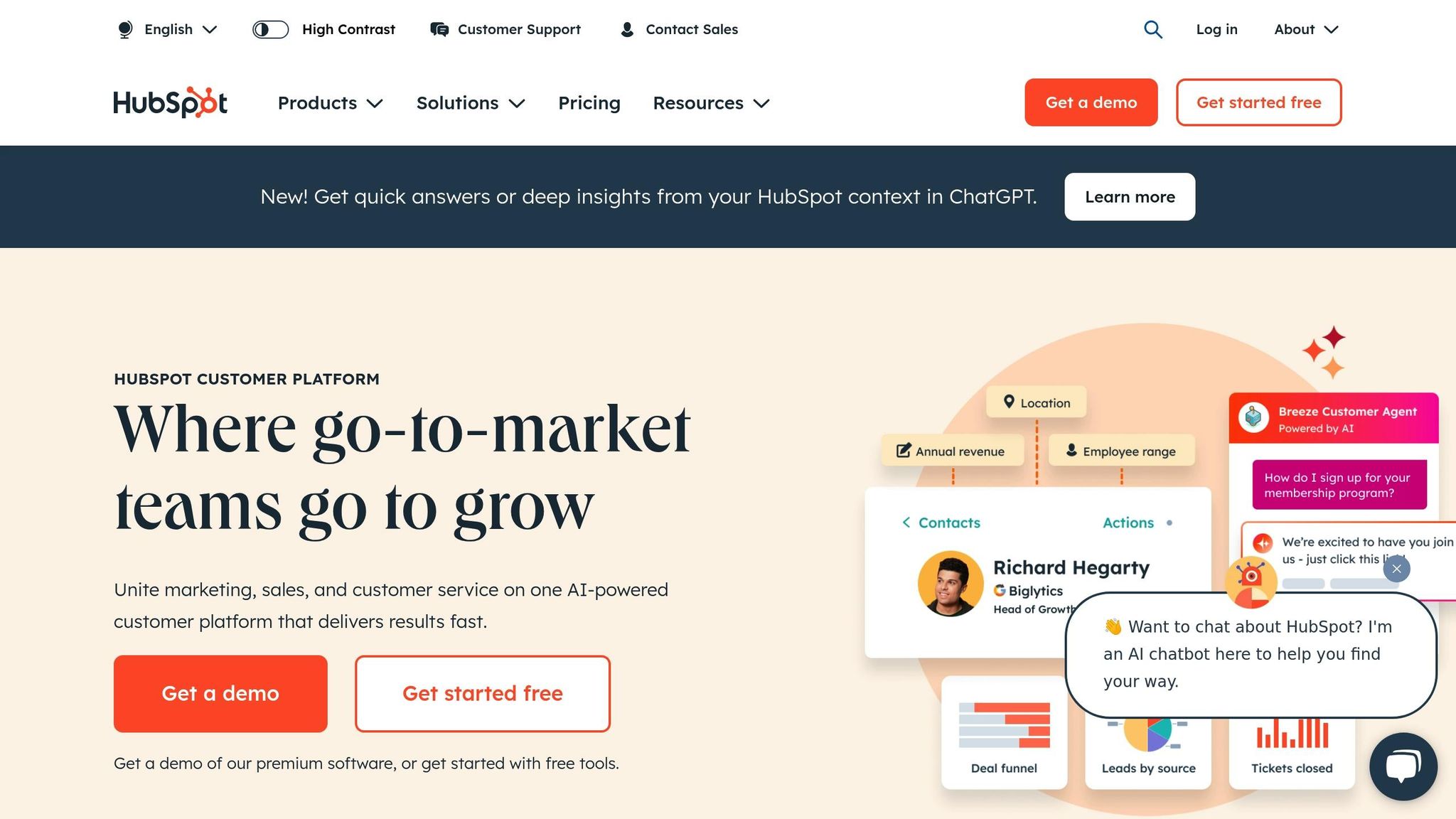Multi-touch attribution tracks how different marketing touchpoints contribute to a conversion. Instead of crediting just one interaction (like first-click or last-click), it assigns value across the entire customer journey. This approach provides a clearer understanding of which campaigns, channels, or interactions are driving results.
Key Takeaways:
- Multi-touch attribution helps optimize PPC campaigns by identifying which touchpoints impact conversions the most.
- Common models include Linear, U-Shaped, W-Shaped, Time Decay, and Data-Driven attribution.
- Clean data, proper tracking (like UTM parameters), and connected tools (e.g., CRMs, analytics platforms) are essential for accurate attribution.
- Businesses can use tools like Google Analytics 4, HubSpot, or Adobe Analytics for implementation, or opt for custom solutions for complex journeys.
Next Steps:
- Define clear goals and conversion events.
- Ensure consistent tracking and data quality.
- Choose an attribution model that aligns with your sales cycle and customer behavior.
- Regularly test and refine your setup for better insights.
This method is increasingly popular among marketers, with 52% adopting it in 2024. Ready to see what’s driving your conversions? Let’s dive in.
Let's Build Multi-Touch Attribution in HubSpot with Sarah Lane-Hawn

Requirements for Multi-Touch Attribution Setup
Laying the groundwork properly can save you time and help you make smarter decisions. These steps are essential for choosing the right attribution model and setting up your tracking systems effectively.
Define Goals and Conversion Events
Setting clear, measurable goals is non-negotiable. Vague objectives lead to data that lacks direction, and poor data quality can cost companies an average of $12.9 million annually. A lot of this waste comes from unclear goals during the initial setup.
Pin down conversion events that directly impact your business - like leads, opportunities, or revenue. You can also define custom goals for specific actions, such as form submissions, demo requests, or changes in pipeline stages.
The focus should be on improving both ROI and user experience. For instance, if you're running PPC campaigns on platforms like Google Ads, Facebook, and LinkedIn, your primary goal might be generating qualified leads, while secondary goals could include email signups or whitepaper downloads. This dual approach helps you track not just final conversions but also how different channels contribute to each phase of the customer journey.
With clear goals in place, you can choose an attribution model that matches your sales cycle and campaign needs. For example, a B2B software company with a lengthy six-month sales cycle will have different needs than an e-commerce brand focused on quick purchases.
Maintain Data Quality and Consistent Tracking
Accurate multi-touch attribution relies on clean, consistent data across all your marketing channels.
A strong UTM strategy is the backbone of effective cross-platform analytics. This includes creating standardized naming conventions, using consistent parameter formats, and maintaining a clear campaign hierarchy.
Here’s how consistent tracking can be implemented:
| Practice | Description |
|---|---|
| Strict UTM Naming Conventions | Establish and document clear naming rules for UTM parameters. |
| Data Validation and Quality Checks | Set up processes to monitor for broken tracking codes, duplicates, and conversion tracking errors. |
| Tag Management Systems | Use tag management tools to easily update and manage tracking codes. |
| Platform Audits | Regularly audit platforms to ensure tracking consistency. |
To ensure long-term data integrity, implement strict governance frameworks that cover access, ownership, and data unification. This isn’t just about using the right tools - it’s about creating processes that maintain data quality over time.
Ongoing maintenance is key. Schedule regular audits to check data accuracy across platforms, apply validation rules to your CRM systems, and monitor metrics like data completeness, accuracy, and consistency. Since human error is a common cause of data issues, training your team on proper data entry practices is crucial.
Once your data is in good shape, the next step is connecting your tools to create a unified view of the customer journey.
Connect Platforms and Tools
For multi-touch attribution to work, your tools need to communicate seamlessly. This involves ensuring smooth data flow between your analytics platforms, advertising channels, and CRM systems.
The technical side includes tracking website visitors - how they arrived, what they did, and whether they converted - using JavaScript, UTM parameters, and APIs. This data should then be centralized in a data warehouse like Snowflake. Multi-touch attribution tools piece together these touchpoints into a clear path, showing who clicked which ad on which platform and when.
When selecting attribution software, prioritize tools that integrate smoothly with your existing marketing stack. Look for compatibility with platforms like Shopify or WooCommerce and tools offering a wide range of native integrations. The goal is to unify the customer journey without the hassle of manual data handling.
Ensure consistent UTM tagging across all campaigns and verify that your customer data platform (CDP) can unify user identities across devices and platforms. This is especially critical since 90% of people switch between devices to complete tasks.
Getting this setup right can pay off significantly. Businesses using advanced multi-touch attribution tools have seen ROI improvements of up to 30%. But this only works if your platforms are properly connected and sharing clean, accurate data about every interaction.
Keep in mind that multi-touch attribution tracks how users interact across channels and assigns value to multiple touchpoints. This differs from multi-channel attribution, which only looks at interactions across platforms. Understanding this distinction will help you structure your tools and data flows effectively.
Select the Right Multi-Touch Attribution Model
Once your platforms are connected and your data is flowing smoothly, the next big step is choosing the right multi-touch attribution model. According to recent research, 75% of companies now use multi-touch attribution, with each model tailored to the unique characteristics of different sales cycles.
The key is to align your attribution model with real customer behavior. For instance, a B2B software company with a six-month sales cycle will need a different approach than an e-commerce business focused on quick, impulse-driven purchases.
Popular Attribution Models
Each attribution model distributes credit for conversions in its own way, following specific rules or patterns.
- Linear Attribution: This model assigns equal credit to every touchpoint in the customer journey. For example, if a customer interacts with your brand through five channels before converting, each channel gets 20% of the credit. Linear attribution is ideal for campaigns with extended consideration periods where consistent messaging across channels is important. However, it can oversimplify things and fail to highlight which touchpoints are truly driving conversions.
- U-Shaped (Position-Based) Attribution: This model gives the most credit - usually 40% each - to the first and last interactions, while the remaining 20% is divided among the middle touchpoints. It’s a good fit for businesses focused on both lead generation and final conversions.
- W-Shaped Attribution: This approach emphasizes three critical moments in the customer journey: the first interaction, lead generation, and the final conversion. These key touchpoints receive the bulk of the credit, with the rest shared among the other interactions. It’s particularly useful for complex, multi-channel campaigns.
- Time Decay Attribution: This model gives more weight to touchpoints that occur closer to the conversion, with earlier interactions receiving less credit. It’s great for campaigns where the most recent interactions are likely to have the biggest impact.
- Data-Driven Attribution: Using machine learning, this model analyzes customer journey data to determine which touchpoints have the greatest influence on conversions. Unlike rule-based models, it adapts to actual patterns in your data. While powerful, this approach requires a significant amount of data and technical resources to implement effectively.
With these options in mind, consider which model aligns best with your business goals and customer journey.
How to Choose the Right Model
The best attribution model for your business depends on your sales cycle, objectives, and the complexity of your customer journey.
- Match your model to your sales cycle and goals: For longer sales cycles, linear or time-decay models may work well. Shorter cycles might benefit from first-touch or last-touch models. For example, first-touch attribution is effective for building initial awareness, while last-touch attribution is better for direct-response campaigns. U-shaped models provide a balanced view of the entire funnel, from awareness to conversion.
- Consider the complexity of your customer journey: Simple customer paths with just a few touchpoints may not require a sophisticated model. On the other hand, intricate B2B sales processes often benefit from more detailed approaches like W-shaped or data-driven models.
Start with simpler models and transition to more advanced options as your data quality and expertise grow. This gradual approach helps you build confidence in your data and refine your strategies over time.
For example, XYZ Blog initially used a first-touch attribution model but found it inadequate for capturing the full scope of their customer journey. After collecting more detailed data, they switched to a time-decay model, which gave greater credit to interactions closer to the conversion. This change led to better insights, improved engagement, and higher conversions.
Attribution Model Comparison
| Attribution Model | Credit Distribution | Best Use Cases | Key Limitations |
|---|---|---|---|
| Linear | Equal credit across all touchpoints | Long sales cycles, omnichannel campaigns | May oversimplify individual touchpoint impact |
| U-Shaped | 40% to first and last touchpoints; 20% split among middle touches | Balancing lead generation and conversions | Lacks nuance |
| W-Shaped | High credit to first interaction, lead generation, and final conversion | Complex, multi-channel campaigns | Requires multiple touchpoints |
| Time Decay | More credit for touchpoints closer to conversion | Dynamic customer behaviors | May undervalue early interactions |
| Data-Driven | Machine-learned credit allocation | Large datasets, complex journeys | Needs significant data and technical resources |
When deciding between rules-based and algorithmic approaches, keep in mind that rules-based models follow predefined credit allocation rules, while algorithmic models rely on statistical analysis and machine learning to objectively assign credit. Your choice will depend on your technical capabilities and the quality of your data.
Whichever model you choose, ensure it supports cross-device tracking to capture the entire customer journey. This will give you a clearer picture of how your marketing efforts drive conversions.
sbb-itb-89b8f36
Step-by-Step Multi-Touch Attribution Setup
Implementing multi-touch attribution allows you to capture every meaningful interaction customers have with your PPC campaigns, giving you a clearer picture of their journey.
Map the Customer Journey
Start by documenting all the touchpoints your customers encounter - both online and offline. This includes everything from social media clicks to in-store visits. By doing this, you’ll get a complete view of the customer journey.
Gather data from all relevant channels and identify the key interactions that lead to conversions. Each touchpoint represents a potential influence on a customer's decision to convert. Collect feedback at these touchpoints to assess their role in the process. This step helps you determine which interactions are most impactful and highlights areas where customers may face challenges or confusion.
To bring this journey to life, create a detailed map that outlines the typical path from awareness to conversion. Include the sequence of touchpoints, the timing between them, and the different routes customers might take based on their needs or behaviors. Be sure to incorporate offline interactions, such as phone calls or in-store visits, alongside digital data. Ignoring offline touchpoints can leave significant gaps in your analysis.
Once you’ve mapped the journey, set up systems to track these interactions effectively.
Configure Tracking Systems
To capture every interaction, install JavaScript tracking across all pages of your website and use UTM parameters with consistent naming conventions. This will ensure you’re collecting data on the full user experience.
Assign unique IDs to each channel to connect interactions across platforms and devices. This step is crucial for building a complete picture of how customers move between touchpoints.
Centralize your marketing data in a CRM system to simplify analysis. Ensure your CRM integrates smoothly with all your marketing platforms to automate data collection. If your campaigns are complex and span multiple channels, consider investing in third-party attribution software. These tools can provide a more accurate view of how credit for conversions should be distributed across touchpoints compared to basic analytics platforms.
Pay special attention to potential data gaps, particularly with offline sources like phone calls, which can be harder to track and integrate with online data. Accurate data collection is the foundation of effective multi-touch attribution.
With tracking in place, the next step is to test and refine your setup.
Test and Improve Attribution Setup
Regularly analyze your attribution data to identify trends and areas for improvement. Focus on understanding which touchpoints are driving results and which might need adjustments.
Use techniques like incrementality testing and media mix modeling to validate your findings. For example, geo-holdouts or A/B tests can confirm whether the touchpoints you're crediting are genuinely driving incremental conversions.
Based on your insights, experiment with new strategies. This could include tweaking messaging, changing ad placements, or reallocating budgets to focus on the most effective customer paths. Treat your attribution framework as a work in progress - continuously refine it as you gather more data.
Dive deeper into your data by using trend analysis and cohort reviews to enhance accuracy. This approach can uncover differences in how various customer groups interact with your campaigns, allowing you to fine-tune touchpoints for specific audiences.
Finally, test different attribution models to find the one that aligns best with your business goals. You can even run parallel models and use A/B testing to see which provides the most actionable insights. As customer behavior evolves, be prepared to adjust your strategy to stay aligned with their needs.
Setting up multi-touch attribution requires time and persistence. Focus first on establishing accurate tracking, and as you collect more data, refine your approach to better understand your customers' behaviors.
Tools and Resources for Attribution
Let’s dive into some platforms and resources that can help you navigate multi-touch attribution and find the right fit for your business goals.
Main Platforms for Multi-Touch Attribution
There’s no one-size-fits-all solution for multi-touch attribution, but several tools cater to different needs and technical setups. Google Analytics 4 offers built-in attribution models and cross-device tracking, making it a go-to option for businesses looking for a straightforward approach. For larger teams already using Adobe’s ecosystem, Adobe Analytics provides enterprise-level attribution capabilities that integrate seamlessly with other Adobe tools.
If you’re looking for a CRM-integrated solution, HubSpot Attribution might be the answer. It allows you to analyze marketing campaigns while keeping customer relationship data centralized, making it easier to link attribution insights to sales and customer lifecycle management.
Other niche tools include HockeyStack, which focuses on mapping B2B SaaS customer journeys, and Wicked Reports, ideal for tracking real-time e-commerce conversions. For businesses that need to integrate both online and offline data - like phone calls or in-store visits - LeadsRx is a popular choice.
For mobile-first businesses, AppsFlyer and Adjust specialize in tracking app installs and managing cross-device campaigns, ensuring you can measure mobile engagement effectively.
Using the Top PPC Marketing Directory
Feeling overwhelmed by the number of tools available? The Top PPC Marketing Directory simplifies your search. This curated resource highlights vetted attribution tools and agencies that specialize in multi-touch attribution, saving you hours (if not weeks) of research.
In the directory, you’ll find tools categorized for performance tracking and campaign management. Many of these platforms offer features like multi-channel tracking, customizable attribution models, and seamless integration with your existing marketing systems. This makes it easier to choose solutions that align with your attribution goals without risking a mismatch.
But the directory doesn’t stop at tools - it also connects you with expert agencies. These agencies bring experience in implementing multi-touch attribution strategies and can assist with everything from selecting the right model to integrating complex data systems. If your team lacks the technical know-how for advanced setups, partnering with an agency can make all the difference.
The featured listings in the directory provide peer-validated options, showcasing tools and services that have delivered strong results in attribution and campaign optimization. This can be especially helpful when you’re evaluating where to invest your time and budget.
When to Use Custom Solutions
Sometimes, pre-built platforms just don’t cut it. For PPC campaigns with unique challenges, custom attribution models can provide deeper insights. For instance, businesses with long B2B sales cycles involving multiple decision-makers often need tailored solutions to accurately track every touchpoint.
Multi-location businesses with both online and offline interactions also benefit from custom setups. A great example is Rogers Communications, which used a custom attribution approach to better understand phone conversion values. This strategy cut their cost per acquisition by 82% over two years.
Custom attribution models are worth considering if your business faces unique challenges, like revenue-based channel weighting, niche customer behaviors, or complex interactions across marketing channels. However, building a custom model isn’t a light lift. You’ll need clean, well-organized data (ideally in a data warehouse) and expertise in tools like Google Analytics 4, BigQuery, and SQL.
As Jonathan Wehausen from Seer Interactive puts it:
"Attribution modeling is not static – it is a framework & set of rules YOU control".
Before committing to a custom solution, assess your channel complexity. If your campaigns span search, social, email, affiliates, and offline channels, the insights gained from custom modeling could be worth the investment. But for simpler setups, established platforms often deliver the insights you need without the added cost and effort of custom development.
The key is to weigh your business’s specific needs against the resources required to build and maintain a custom solution. If the benefits outweigh the effort, a tailored approach can unlock insights that help you make smarter marketing decisions.
Conclusion
Multi-touch attribution is changing the game for PPC campaigns. Instead of giving all the credit to a single interaction, it allows you to analyze the entire customer journey, helping you make smarter decisions that lead to better results.
In 2024, 52% of marketers adopted multi-touch attribution, with 57% describing it as "crucial as part of an ensemble of measurement solutions". It’s clear this method is becoming the go-to approach for marketers aiming to boost ROI and pinpoint what truly drives conversions.
Key Points
To make the most of multi-touch attribution, you’ll want to focus on three main pillars:
- Choose the right attribution model: Whether it’s linear, time decay, or a custom setup, pick a model that reflects your customer journey and aligns with your goals.
- Ensure clean and consistent data: Reliable data is essential. Without it, even the most advanced attribution model won’t provide useful insights.
- Use tools that match your needs: From straightforward options like Google Analytics 4 to more tailored solutions, select tools that fit your campaign's complexity and your team's technical skills. Notably, 41% of marketing organizations are already using attribution modeling to measure ROI.
Next Steps for Marketers
Start by setting clear goals and metrics. Are you looking to allocate your budget more effectively, identify key touchpoints driving high-value actions, or improve performance at specific stages of the funnel? Your objectives will shape your entire strategy.
For guidance, check out the Top PPC Marketing Directory, which features vetted tools and expert agencies specializing in multi-touch attribution. This resource can save you time and connect you with solutions that have a proven track record in driving campaign success.
FAQs
What challenges do businesses face with multi-touch attribution, and how can they address them?
Implementing multi-touch attribution isn’t always straightforward. Challenges like complex data, assigning credit across multiple touchpoints, privacy regulations, and integrating data from different platforms can make it tough to get clear insights into your campaigns.
To tackle these hurdles, start by simplifying how you manage data. Leverage advanced analytics tools to better understand performance, and ensure your processes align with privacy laws. Using a centralized data platform can also streamline the process, helping you bring all your information together in one place. This makes tracking and optimizing your PPC campaigns much more manageable.
What is multi-touch attribution, and how does it differ from traditional single-touch models?
Multi-touch attribution is all about tracking and giving credit to every interaction a customer has with your marketing before they convert. Instead of zeroing in on just one touchpoint, like traditional single-touch models do, this method paints a clearer picture of how various channels and campaigns work together to drive conversions.
Marketers are turning to multi-touch attribution because it offers a better understanding of customer behavior. It reveals which strategies actually deliver results, enabling businesses to fine-tune their campaigns and invest their budgets in the channels that make the biggest impact.
What should businesses consider when selecting a multi-touch attribution model?
When deciding on a multi-touch attribution model, it's important to consider a few critical elements to ensure it aligns with your business needs:
- Marketing objectives: Match the model to your campaign goals, whether that's boosting ROI, understanding customer behavior, or refining your strategies.
- Customer journey complexity: Think about how many touchpoints your customers encounter before making a purchase or completing a conversion.
- Data quality and availability: Make sure the data you’re working with is accurate and comprehensive enough to support the model’s requirements.
- Resource capacity: Evaluate whether your team has the necessary tools, skills, and bandwidth to implement and interpret the model effectively.
By taking these aspects into account, you’ll be better equipped to choose a model that delivers meaningful insights and helps optimize your PPC campaign performance.


